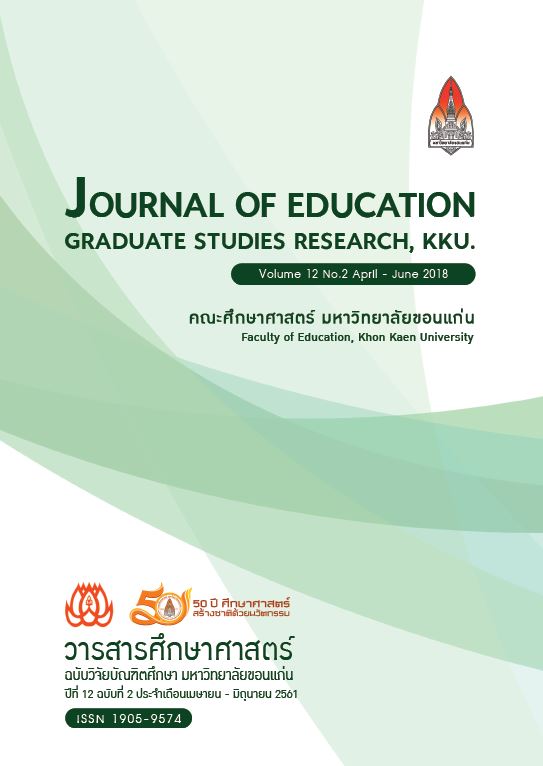Teacher Competency Factors Affecting High Performing School under the Office of Secondary Educational Service Area 25
Main Article Content
Abstract
The objectives of this descriptive research were to 1) study the level of teacher competency factors and the level of being a high-performing schools under The Office of Secondary Educational
Service Area 25, 2) study the relationship between teacher competency factors and the high-performing organization of these schools, and 3) study the teacher competency factors affecting the high-performing organization of these schools. The sampling group, selected through multi-stage sampling method, consisted of 84 school administrators and 351 teachers. Research instrument was a questionnaire with 5-level rating scale. Data was analyzed using the computer program for descriptive statistics and stepwise multiple regression analysis. Findings were as follows: 1) Overall factor of teacher competency indicated a high level of action. The highest mean score of competency was found with morality and ethics of teaching profession. It was respectively followed by student development, educational measurement and evaluation, curriculum management and learning management, building up a relationship and collaboration with community for learning management, classroom management, and language and technology for teachers. 2) Overall aspect of high-performing organization of schools indicated a high level of action. The highest mean score of competency was found with two aspects including the high academic standard and learning achievement and the learning-supported environment. They were respectively followed by having shared vision, students’ learning focus, professional development focus affecting learning and teaching, effective organizational leading, teamwork with strong cooperative communication, curriculum and instruction and evaluation affecting effectiveness, monitoring the progress of learning and teaching for students’ achievement, language and technology for teachers, and strong collaboration with parent and community for learning support. 3) It was predicted that the 6 factors of teacher competency including student development, curriculummanagement and learning management, classroom management, morality and ethics of teaching
Article Details
References
จันทรรัตน์ สิทธิสมจินต์. (2559). การพัฒนาแนวทางการจัดการนวัตกรรมที่ส่งผลต่อโรงเรียนสมรรถนะสูง. วิทยานิพนธ์ศึกษาศาสตรดุษฏีบัณฑิต. สาขาวิชาการบริหารการศึกษา บัณฑิตวิทยาลัย มหาวิทยาลัยขอนแก่น.
นุชนรา รัตนศิระประภา. (2557). ศึกษาสมรรถนะของผู้บริหารที่ส่งผลต่อคุณลักษณะโรงเรียนมาตรฐานสากล สังกัดสำนักงานคณะกรรมการการศึกษาขั้นพื้นฐาน. วารสารวิชาการ VeridianE- Journal. 7(3), 507-508.
บุญชู สุนธงศิริ. (2557). ภาวะผู้นำ ที่ส่งผลต่อองค์การที่มีสมรรถนะสูงของสถานศึกษาในสังกัดสำ นักงานเขตพื้นที่การศึกษามัธยมศึกษาเขต 27. วิทยานิพนธ์ศึกษาศาสตร มหาบัณฑิต. สาขาการบริหารการศึกษา บัณฑิตวิทยาลัย
มหาวิทยาลัยขอนแก่น.
พิมพันธ์ เดชะคุปต์. (2558). การจัดการเรียนรู้ในศตวรรษที่ 21. กรุงเทพฯ. จุฬาลงกรณ์มหาวิทยาลัย.
มานะ สินธุวงษานนท์. (2550). ปัจจัยส่งเสริมการจัดการศึกษาที่ส่งผลต่อคุณภาพนักเรียนในภาคตะวันออกเฉียงเหนือ.วารสารศึกษาศาสตร์, 18(2),115-128.
เวียงวิวรรธน์ ทำทูล. (2557). ภาวะผู้นำ เชิงนวัตกรรมของผู้บริหารที่ส่งผลต่อองค์การขีดสมรรถนะสูงของโรงเรียนในสังกัดสำนักงานเขตพื้นที่การศึกษามัธยมศึกษาเขต 21.วิทยานิพนธ์ปริญญาศึกษาศาสตรมหาบัณฑิต. สาขาวิชาการบริหารการศึกษา บัณฑิตวิทยาลัยมหาวิทยาลัยขอนแก่น.
สงวนพงศ์ ชวนชม. (2557) . ความสัมพันธ์ระหว่างการบริหารงานวิชาการกับประสิทธิผลของสถานศึกษาสังกัดองค์การบริหารส่วนจังหวัดนครราชสีมา. วารสารวิชาการสมาคมสถาบันอุดมศึกษาแห่งประเทศไทย (สสอท.), 20(2), 59-68.
สมจิตร อุดม. (2556). สมรรถนะของครูและบุคลากรทางการศึกษาที่ส่งผลต่อการสร้าง ความสัมพันธ์ระหว่างโรงเรียนกับชุมชนในจังหวัดภาคใต้. วิทยานิพนธ์ปริญญาศึกษาศาสตรมหาบัณฑิต สาขาวิชาหลักสูตรและการสอน บัณฑิตวิทยาลัย คณะศึกษาศาสตร์ มหาวิทยาลัยทักษิณ.
สุรเดช อนันตสวัสดิ์. (2554). โมเดลเชิงเหตุและผลของสมรรถนะครูสังกัดสำนักงานคณะกรรมการการศึกษาขั้นพื้นฐาน.วิทยานิพนธ์ครุศาสตรมหาบัณฑิต. สาขาวิชาการบริหารการศึกษาบัณฑิตวิทยาลัย จุฬาลงกรณ์มหาวิทยาลัย.
สุริยะ ทวีบุญญาวัตร. (2559). รูปแบบองค์การสมรรถนะสูงของสถานศึกษา สังกัดสำนักงานคณะกรรมการการศึกษาขั้นพื้นฐาน. Veridian Journal, 9(1), 795-814.
สำนักงานเลขาธิการสภาการศึกษา. (2551). สมรรถนะครูและแนวทางการพัฒนาครูในสังคมที่เปลี่ยนแปลง. กรุงเทพฯ: พริกหวานกราฟฟิก.
สำนักงานเลขาธิการสภาการศึกษา. (2552). ระบบโรงเรียนคุณภาพระดับโลก ขึ้นมาสู่ความเป็นโรงเรียนคุณภาพชั้นนำ ได้อย่างไร. กรุงเทพฯ: พริกหวานกราฟฟิก.
สำนักงานเลขาธิการการศึกษา. (2558). ร่างกรอบทิศทางแผนการศึกษาชาติ พ.ศ. 2560-2574. กรุงเทพฯ:
Axix. M. A. (2010). Effects of Demographic Factors and Teachers’competencies on the Achievement of Secondary School Students in Punjab. Journal of educational Research. 13(2), 171-177.
Bergeson. (2007). Nine Characteristics of High-Performing Schools.
Hoy, W. K. and Ferguson, J. (1985). A Theoretical Frame work and Exploration of Organizational Effectiveness in School. Educational Administration Quarterly, 21(2), 121-122.
Karaca, F., Gulfidan, C. and Soner, Y. (2013). A path model for technology integration Into elementary school settings in Turkey. Computer & Education. 68, 353-365.

